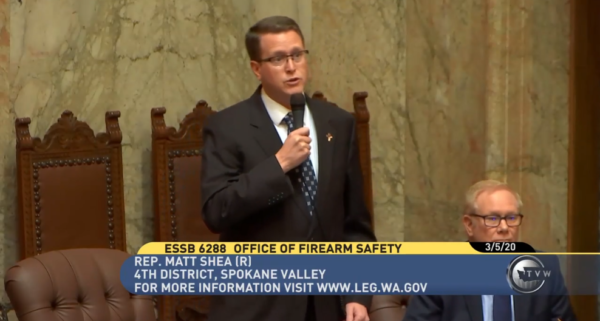
The Washington State House has voted to create what opponents fear will be a taxpayer-funded gun control bureaucracy in the Commerce Department—the Office of Firearm Violence Prevention as defined in Engrossed Substitute Senate Bill 6288—while the state Department of Licensing reported Friday morning that there are now more than 650,000 active concealed pistol licenses in the state.
The measure was previously passed by the Senate.
Washington is the smallest western state with one of the most active gun prohibition lobbying groups in the nation headquartered in Seattle. The billionaire-backed Alliance for Gun Responsibility has pushed through two restrictive gun control initiatives since 2014.
But an effort to make CPLs more difficult to obtain failed during the current legislative session. Now, according to updated Licensing Department figures, there are 650,825 active licenses. That represents 3,592 additional licenses since Liberty Park Press last checked with the agency Jan. 31.
It is a remarkable situation, since Washington is considered a politically “blue” state under Democrat control for most of the last 35 years. There has not been a Republican governor since the early 1980s.
But Second Amendment activists have energized. They formed the “Washington 2020 Legislative Action Group” and the Gun Rights Coalition, initially in an attempt to repeal gun control Initiative 1639, and then to prevent passage of several measures introduced by Democrats that they thought were onerous.
Still, House gun control proponents managed to push through Engrossed Substitute Senate Bill 6288, which establishes the “Firearm Violence Prevention” office within the state Commerce Department. It passed 25-23 in the Senate last month and 53-44 in the House on March 5.
The bill must now be signed off by leaders in both houses and then it goes to the governor. As the Legislature is set to adjourn next week, that process will likely unfold quickly.
But it didn’t happen without considerable debate, especially over language in one section that opponents say clearly suggests the mission is to reduce the number of firearms in the state.
During the floor debate, which may be viewed here, State Rep. Matt Shea (R-Spokane Valley) sought to amend the language of the bill to reflect an effort to reduce “firearms violence.”
However, Rep. Strom Peterson (D-Edmonds) responded, “I think this is an opportunity that we don’t want to turn our back on, I think this is something this legislature has already encouraged with the buyback program with bump stocks so I think we’re on solid ground and we really want to be able to get creative in these communities that are racked by this epidemic of gun violence and reducing the amount of guns, especially guns that might be held illegally, is an opportunity that we should not turn our back on.”
“So this bill isn’t about reducing violence,” Shea fired back, “it’s about reducing the physical number of firearms in Washington State in violation of Article 1, Section 24 of the Washington State Constitution.”
That exchange occurs starting at 2:28:56 in the debate. Shea’s amendment was not adopted. However, immediately following in the bill text are references to “firearm violence reduction.”
Since December 2014, one month after passage of Initiative 594, the so-called “universal background check” measure, Washington has added more than 172,000 CPLs. Over the past 12 months, since March 1, 2019, the number of active licenses climbed more than 37,900 and so far this year, 4,481 new licenses have been added.
With a population hovering between 7.5 and 8 million, by subtracting people under age 21, and those disqualified from owning firearms, a rough estimate would have one out of every 9 or 10 legal adults is licensed to carry. Translate that to having nine of every 100 people one passes on the street might be legally packing. In King County, which encompasses Seattle, there are 104,344 active licenses, which runs counter to the impression that the city is a gun-free zone populated exclusively by Utopian liberals.
Many of those citizens were jarred into reality by the wild downtown shooting in late January that left one woman dead and seven others wounded. It was a gun battle between rival gang members, all with criminal records that disqualify them from owning or possessing firearms, and two of the three were under Department of Corrections supervision at the time. Ammoland reported on that shooting here.
All three suspects in that shooting are now behind bars, awaiting trial.
Worrisome to rights activists is another section of the Senate bill that says this: “Each city that receives a program grant shall distribute no less than fifty percent of the grant funds to one or more of any of the following types of entities: (a) Community-based organizations; and (b) Public agencies or departments that are primarily dedicated to community safety or firearm violence prevention.”
They question what “community-based” organizations will be receiving grant money. The Alliance for Gun Responsibility and Washington Ceasefire are both “community-based” gun control groups, but so are established gun clubs, and the Washington Arms Collectors. Those groups frequently offer firearms safety courses designed to reduce gun mishaps which are often included under the sweeping “gun violence” definition.